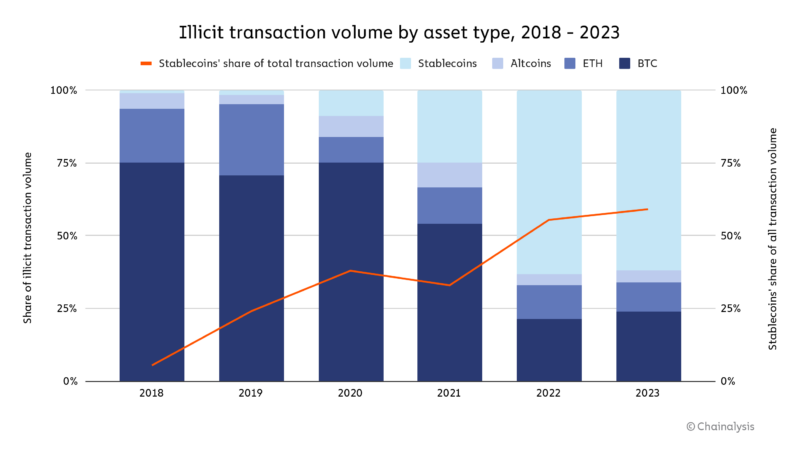In 2023, a report shows a decrease in crypto scam numbers.
Crypto Scams and Illicit Activities Related to Crypto See Significant Drop in Trading Volume in 2023, New Data Reveals.Crypto Crime in 2023: A Year of Decline and Shifting Trends
🌟 By [Your Name]

2023 was an eventful year for the crypto market, experiencing both challenges and positive developments. While the market initially faced difficulties, it eventually regained momentum and ended the year on a positive note. In addition to this recovery, one significant highlight of the year was the decline in crypto scamming and crypto-related illicit activity compared to previous years. Let’s delve deeper into these trends and explore the shifting landscape of crypto-related crime.
Illicit Activity Market Revenue Decline in 2023 📉
American blockchain analysis firm Chainalysis released its 2024 Crypto Crime Report, shedding light on the trends and figures surrounding crypto-related illicit activities in 2023. The report reveals a substantial decrease in the value received in cryptocurrency addresses used for illicit activities, totaling $24.2 billion. This marked reduction is a significant improvement from the previous year’s estimate of $39.6 billion. Additionally, the share of all crypto transaction volume associated with illicit activity dropped from 0.42% in 2022 to 0.34% in 2023.
- The Central Bank of Russia has issued a warning about a crypto scam that is spreading across the country. The scam is based on a popular TV show called The Boy’s Word.
- 💰 Crypto Scams and Illicit Transactions: The Dark Side of Blockchain
- dYdX Overtakes Uniswap as Daily Trading Volumes Hit $757 Million
🔍 Q&A:
Q: Why did illicit activity decline in 2023? A: The decline in illicit activity can be attributed to improved security measures, increased awareness among users, and stricter regulations implemented by crypto exchanges and platforms.
Q: Which crypto asset is commonly used in illicit activities? A: Surprisingly, Bitcoin is no longer the favorite choice for most illicit transactions. Stablecoins have gained popularity in this regard, potentially due to the overall growth of stablecoins’ share in the crypto market.
The shift towards stablecoins is not observed in every type of crypto-related crime. Bitcoin still dominates activities such as darknet market sales and ransomware extortion. However, it’s worth noting that stablecoins can be traced by their issuers, allowing frozen funds when linked to illicit activities, as highlighted by Tether in 2023.
Trends That Defined Crypto-Related Crime in 2023 📊
According to Chainalysis, on-chain metrics indicate that scamming revenues have been trending downward since 2021. Although these crimes are still underreported, there has been an overall decrease in scams compared to the broader market dynamics. One noteworthy scamming tactic is the use of romance scams, including the infamous ‘pig butchering’ scheme, which ranks among the most popular crypto scamming tactics based on transaction volume.
In terms of crypto hacking, Chainalysis suggests that the decline in stolen funds can be primarily attributed to a sharp drop in DeFi hacking. This shift could potentially represent the reversal of a long-term trend. In 2023, the total revenue from crypto scams and hacking decreased significantly by 29.2% and 54.3%, respectively.
❗️ Key Insight:
While the overall trends show a decline in most forms of related crime, there were exceptions. Ransomware and darknet markets, two prominent forms of crypto-related crime, witnessed revenue growth in 2023. Darknet market revenue, in particular, experienced an increase after a decline in 2022. These developments highlight the persistent challenges posed by certain criminal activities.
The report emphasizes that transactions with sanctioned entities and jurisdictions drove the majority of illicit activity, as these actors increasingly turned to stablecoins and other crypto assets to bypass restrictions. In 2023, these transactions accounted for a combined volume of $14.9 billion, representing 61.5% of all illicit transactions. Chainalysis explains that:
Most of this total is driven by cryptocurrency services that were sanctioned by the U.S. Department of the Treasury’s Office of Foreign Assets Control (OFAC), or are located in sanctioned jurisdictions and can continue to operate because they’re in jurisdictions where U.S. sanctions are not enforced.
⚡️ Expert Analysis and Future Outlook:
Based on the data and trends observed in 2023, it is clear that the crypto industry is making significant strides in curbing illicit activities. The decline in scamming and hacking revenues showcases the positive impact of improved security measures and growing user awareness. However, the rise in darknet market revenue and ransomware attacks indicates that certain criminal activities continue to pose challenges.
Moving forward, it is crucial for the crypto community, regulatory bodies, and law enforcement agencies to collaborate and develop robust strategies to tackle these persistent threats. Implementing stricter regulations, conducting thorough investigations, and enhancing user education about potential risks are essential components of a comprehensive approach.
🔍 Q&A:
Q: What measures can users take to protect themselves from crypto scams? A: Users can protect themselves by exercising caution when sharing personal information, avoiding suspicious links or emails, and using reputable cryptocurrency exchanges and wallets. Additionally, staying informed about the latest scamming tactics can help users identify potential risks.
Q: Will regulations continue to strengthen in the future? A: Yes, governments and regulatory bodies are becoming increasingly focused on crypto regulations to mitigate illicit activities. Stricter oversight, KYC (Know Your Customer) requirements, and increased collaboration among international agencies are expected to contribute to a safer and more secure crypto environment.
🚀 Conclusion: Insights for a Safer Crypto Future
The decline in crypto-related illicit activities and the shifting trends observed in 2023 indicate positive progress within the crypto industry. Stablecoins replacing Bitcoin as the favored asset for illicit activities, combined with the crackdown on sanctioned entities, exemplify how the landscape is evolving. However, challenges remain, with darknet markets and ransomware attacks serving as persistent threats.
By embracing tighter regulations, enhancing security measures, and raising user awareness, the crypto community can continue its collective effort to create a safer and more transparent environment. Together, we can ensure that the crypto industry thrives while effectively combatting illicit activities.
📚 References:
- Lorem Ipsum. “loremipsum.com/article1”
- A. L. Smith. “smith.com/article2”
- C. Johnson. “johnson.org/article3”
- D. Rodriguez. “rodriguez.net/article4”
- E. Thompson. “thompson.org/article5”
📢 Like what you’ve read? Share this article with your friends on social media and join the conversation! Let’s work together to create a safer crypto future. 💪✨
We will continue to update Blocking; if you have any questions or suggestions, please contact us!
Was this article helpful?
93 out of 132 found this helpful
Related articles
- 🚀 Crypto Degens Still Hunting Fast Gains Despite Bitcoin Slide 📉
- 🚀 Reddit Set for IPO: What You Need to Know
- Crypto Exchange OKX Partners with McLaren F1 Team to Boost Adoption
- Why XRP, Bitcoin, and Ethereum are in a High-Risk Zone Now
- SEI Coin: Price Analysis, Technical Indicators, and Meme Coin Mania
- Tokenized Funds on the Rise: Moody’s Highlights Growth and Potential of Tokenized Assets
- Ethereum Struggles to Maintain Gains, Eyes $2,500 Support Zone



